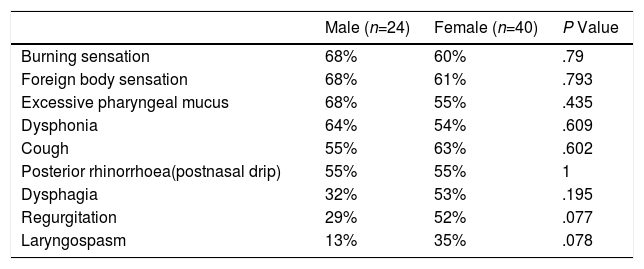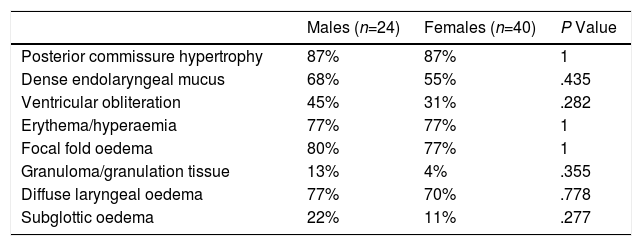To characterise laryngo-pharyngeal reflux (LPR) in patients over 60 years of age.
MethodsRetrospective review of patients over 60 years of age with symptoms suspicious of LPR, seen from 2005 to 2014 at an ENT Department of an academic hospital. Eighty-five consecutive patients (54 females, 31 males) who had completed a dual-sensor 24-hour pH-metry were included (considered “gold-standard” in LPR diagnosis).
Body mass index, and reflux information and interventions were revised. pH-metries were evaluated according to DeMeester & Johnson's criteria. Symptoms were assessed according to the Reflux Symptom Index (RSI) and classified as abnormal if score was ≥13. A naso-fibro-laryngoscopy enabled findings to be documented according to the Reflux Finding Score (RFS), and they were classified as abnormal if the score was ≥7.
ResultsThe patients’ mean age was 67 years. A positive pH-metry was present in 70 patients (82.5%). Fifty patients (59%) had abnormal body mass index, and almost 90% of them had an abnormal pH-metry. Mean RSI score was 9.8, with abnormal results in 24 patients (28%). Only 20 patients (23%) with abnormal RSI had a positive pH-metry. Posterior commissure hypertrophy was the most common finding (90% of patients). Mean RFS score was 9.07, with abnormal results in 69 patients (81%). Sixty-one patients (70%) with abnormal RFS had a positive pH-metry. Only 18 patients (20%) had coincidental abnormal pH-metry, RSI, and RFS.
ConclusionsIn ageing patients, abnormal body mass index is strongly associated with abnormal pH-metry. RSI is a weak indicator of LPR, whereas RFS has a moderate value.
Caracterizar la enfermedad por reflujo faringolaríngeo en pacientes de edad avanzada y ancianos.
MétodosEstudio retrospectivo de pacientes mayores de 60 años, con sintomatología sugestiva de enfermedad por reflujo faringolaríngeo, vistos entre 2005 y 2014 en el Departamento de Otorrinolaringología de un hospital universitario. Se seleccionaron 85 pacientes (54 mujeres y 31 hombres) sometidos a una pH-metría de 24h con doble sensor («gold standard» en el diagnóstico del reflujo).
Se calculó el índice de masa corporal. Se revisó la información clínica y evaluaron las pH-metrías según los criterios de DeMeester y Johnson. Se revisó el cuestionario «Reflux Symptoms Index» (RSI), considerado patológico cuando fue ≥13. Se evaluaron los hallazgos endoscópicos faringolaríngeos del «Reflux Finding Score» (RFS), considerado patológico cuando fue ≥7.
ResultadosLa edad media fue 67 años. En 70 pacientes (82%) la pH-metría fue patológica. El índice de masa corporal fue patológico en 50 pacientes (59%), de los que casi el 90% tenían pH-metría patológica. El RSI medio fue 9,8, con resultados anormales en 24 pacientes (28%). En 20 pacientes (23%) con RSI anormal tenían una pH-metría positiva. El hallazgo endoscópico más común (90%) fue la hipertrofia de comisura posterior. El RFS medio fue 9,07, con resultados anormales en 69 pacientes (70%). En 61 pacientes (70%) con RFS anormal tenían una pH-metría patológica. Solo 18 pacientes con RSI y RFS patológicos tenían una pH-metría patológica.
ConclusionesEn pacientes mayores, los valores patológicos de índice de masa corporal se asocian altamente con pH-metrías patológicas. El RSI es un indicador de poco valor, mientras que el RFS es de valor moderado.









